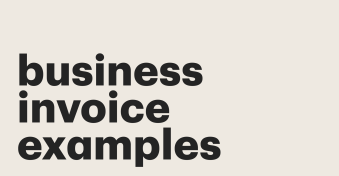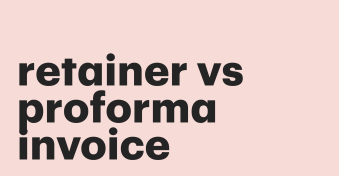An invoice approval workflow is the process you or your company takes to validate and pay invoices.
The steps involved in an invoice approval system typically include verification, discrepancy checking, approval, and processing.
By utilizing invoice approval software, you can eliminate the errors and bottlenecks associated with manual invoice workflows.
Having an efficient, automated invoice approval workflow can help you avoid pitfalls, wasted time, and lost revenue by keeping your business operations running smoothly.
This software allows you to set up an invoice approval workflow within minutes, transforming your business by automating tedious tasks with PandaDoc.
How does the ideal invoice approval workflow function?
Although invoice approval workflows may differ from business to business, most will contain the following steps:
- Verification. Checking all the information in the invoice. This could be from receipts, order documents, progress reports, and any other relevant documents.
- Extra information. If you feel there are any discrepancies (or missing information), then you should check and clarify with the appropriate team members or managers.
- Approval. Once the info contained in the invoice is correct, it needs to be signed off by a manager who can approve invoice payments.
- Processing. The final stage is sending invoice payment. This will happen via a route agreed between the two parties in advance. It may take the form of a bank transfer, or it may be by business check. It’s worth noting that payment will often take place within an agreed time frame.
Benefits of invoice approval workflow software
A manual invoice approval process can create many potential barriers to operational efficiency and invoice management.
That means that an automated invoice approval system may be beneficial to your business processes.
1. Time saving
One of the main benefits of using an invoice approval workflow software is the amount of time it saves.
When your staff doesn’t have to spend a lot of time checking invoice details or invoice matching, they can focus their attention on other tasks, boosting productivity.
2. Account management
When doing manual invoice approval workflows, it is typically managed by an accounts payable team.
This can be time-consuming and distract them from other finance-related tasks, such as supporting your sales staff or developing better customer and supplier relationships.
By implementing an automated system with workflow automation apps, you are minimizing the time spent on invoicing.
3. Reduce human error
When you remove human error from the equation, you should see increased accuracy at every step of your invoice approval workflow.
This can be applied to each step of the invoice approval process, from manual data entry to reviewing invoice details. Invoice approval process automation allows authorized parties to electronically sign any invoice.
4. Improved business processes
It may not seem like it, but invoice management can be a very stressful process.
Your staff may be working within tight timeframes where invoices have to be sent or paid by a certain date.
This also applies when payment discounts are involved. You can set up your approval software to ensure all deadlines are met.
This means that you are reducing the stress placed on staff, and they can focus more energy and productivity elsewhere.
5. Cost effective
One advantage of implementing invoice approval workflow software is that it will save you on business costs in the long-term.
You will make savings in both time and labor costs associated with manual processes.
How to set up invoice approval automation
Setting up an automated invoice approval workflow with PandaDoc is straightforward and can significantly enhance your accounts payable process.
Here’s a step-by-step guide to help you get started:
Step 1: Assess your current process
Begin by evaluating your current invoice approval process. Identify the pain points and inefficiencies that automation can address.
- Who currently approves invoices?
- How long does the process take?
- Where do errors most frequently occur?
Step 2: Define workflow stages
Outline the key stages of your invoice approval workflow.
A typical process includes:
- Invoice submission: Invoices are received and logged into the system.
- Verification: Details such as invoice number, date, and amount are verified.
- Discrepancy checking: Any discrepancies are flagged and addressed.
- Approval: Invoices are sent for approval to the designated individuals.
- Processing: Approved invoices are processed for payment.
Step 3: Set up approval roles
Determine who will be responsible for each stage of the workflow.
In small businesses, this might involve a few key individuals, while larger companies may have a more complex hierarchy. Ensure that:
- Each role is clearly defined
- Approvers are designated for each step
- There is a system for handling exceptions and escalations
Step 4: Configure PandaDoc
Log in to PandaDoc and configure your invoice approval workflow:
1. Create templates: Use PandaDoc’s smart content and templates to create standardized invoice approval documents.

2. Set permissions: Assign permissions to different users based on their roles in the approval process.
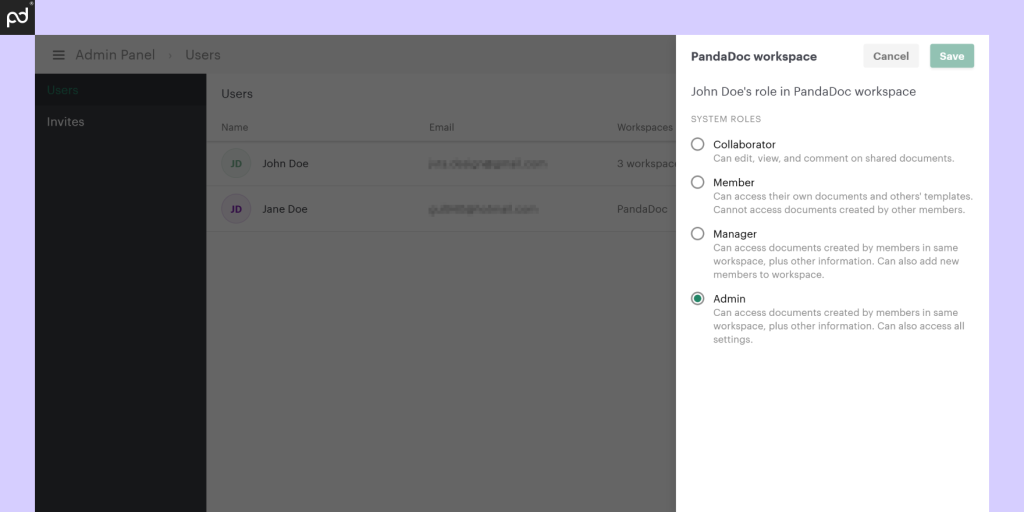
3. Automate notifications: Set up automated notifications and reminders to keep the process moving smoothly.
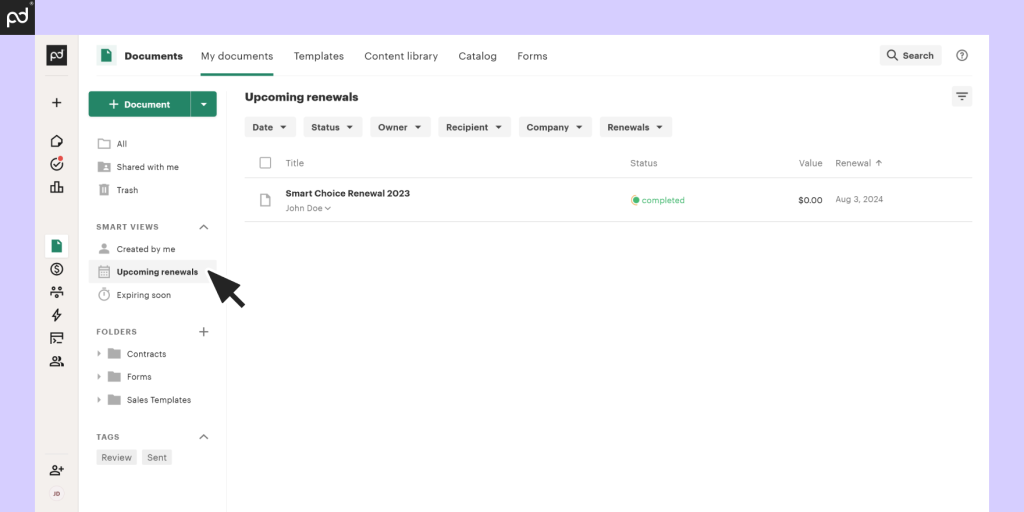
Step 5: Test the workflow
Before rolling out the new workflow, conduct a thorough test.
Run several invoices through the system to ensure that each stage works correctly and that all notifications are triggered as expected.
Adjust any settings or permissions as necessary.
Step 6: Onboard your team
PandaDoc’s user-friendly interface makes this process quick and easy.
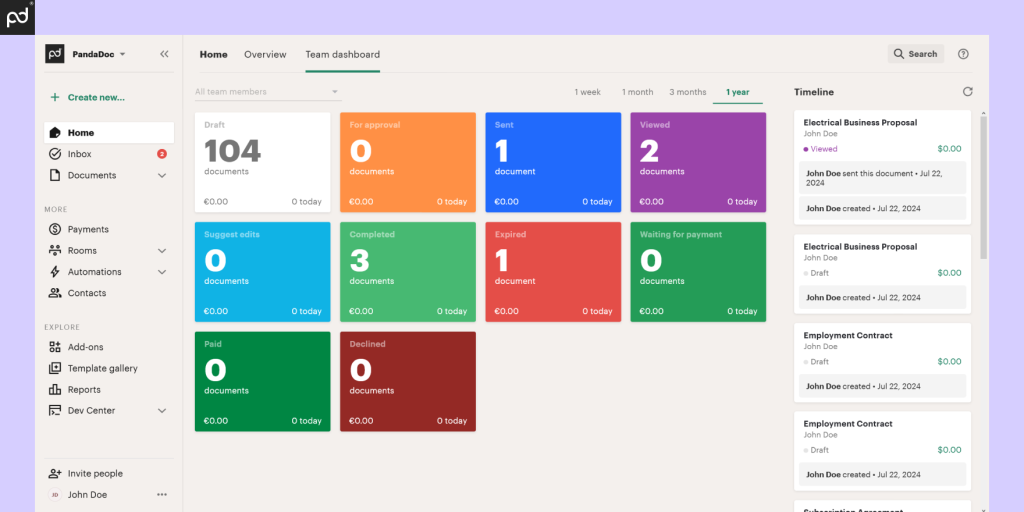
Consider the following:
- Training sessions: Conduct training sessions to familiarize your team with the new workflow.
- Documentation: Provide comprehensive documentation and support resources.
Step 7: Monitor and optimize
Once the workflow is live, continuously monitor its performance.
Use PandaDoc’s analytics to identify any bottlenecks or issues. Regularly seek feedback from your team and make adjustments to optimize efficiency.
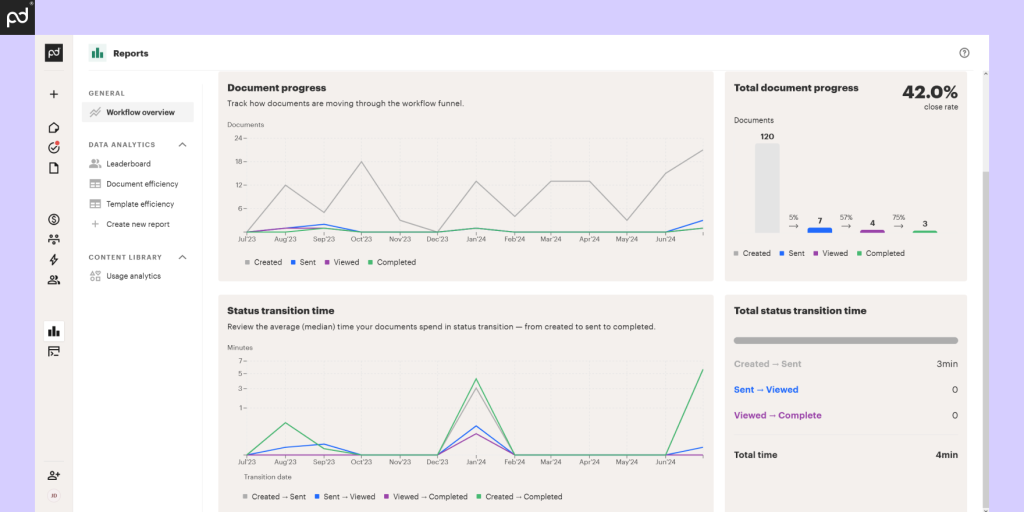
Insider pro tips
Who approves invoices?
In smaller businesses, this might be the owner or a financial manager.
In larger companies, it could involve multiple layers of approval from department heads to CFOs.
How long to onboard?
Onboarding can be quick, typically a few hours for small teams.
For larger teams, plan for a phased approach to ensure everyone is trained.
Shared responsibilities
It’s beneficial to share the responsibility of invoice approval rather than assigning it to a single person. This reduces the risk of bottlenecks and errors.
By automating your invoice approval process with PandaDoc, you can ensure that invoices are processed efficiently and accurately.
Start your journey towards efficient invoice management today with PandaDoc’s robust solutions by scheduling a demo today.
Disclaimer
PandaDoc is not a law firm, or a substitute for an attorney or law firm. This page is not intended to and does not provide legal advice. Should you have legal questions on the validity of e-signatures or digital signatures and the enforceability thereof, please consult with an attorney or law firm. Use of PandaDocs services are governed by our Terms of Use and Privacy Policy.
Originally published September 13, 2023, updated August 6, 2024
